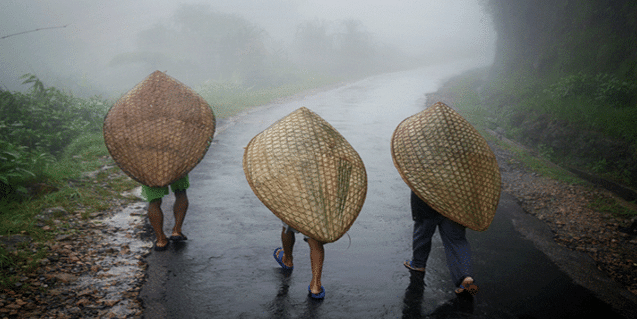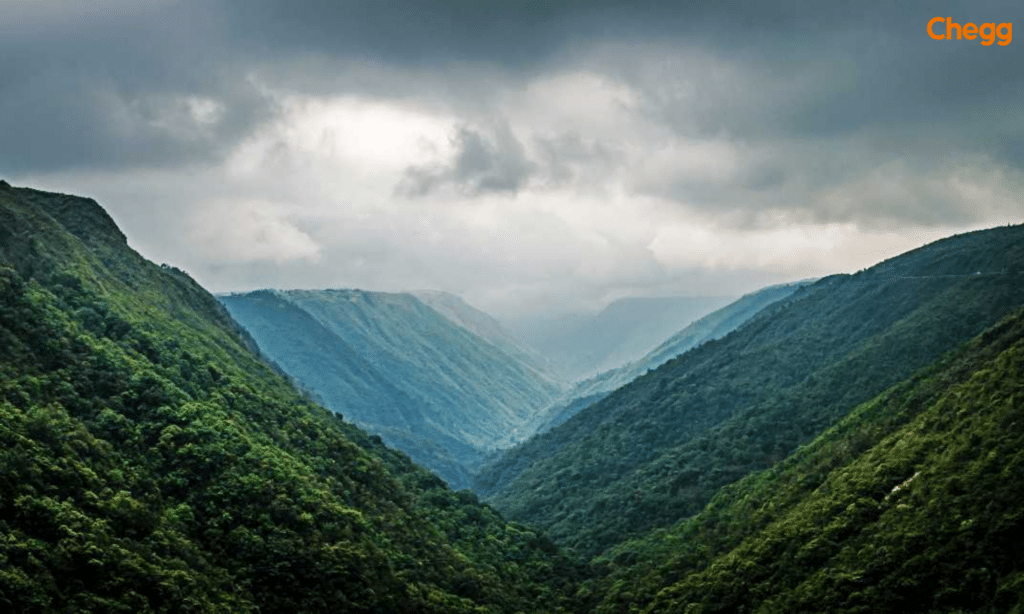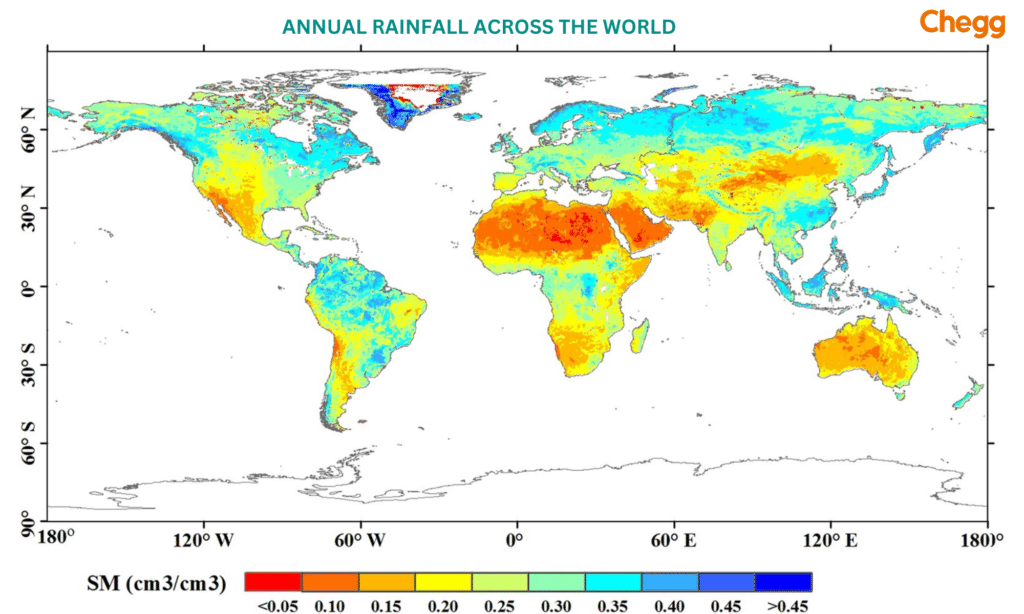
Quick Summary
Table of Contents
Mawsynram, a village in Meghalaya, India, holds the title of the wettest place on Earth, with over 11,800 mm (467 inches) of rainfall annually. Located in the East Khasi Hills, its unique geography causes intense orographic rainfall as moist winds from the Bay of Bengal hit the hills and rise. Mawsynram surpasses Cherrapunji, which previously held the record, and continues to fascinate meteorologists, travelers, and nature lovers.
This small village, situated in the East Khasi Hills, surpassed its own records in 2022 when it experienced a remarkable 1003 mm of rain in just one day. The region’s exceptional rainfall is a result of its geographical positioning and unique climatic conditions.
The constant downpours are a result of orographic rainfall, where moist air from the Bay of Bengal is forced upward by the Khasi Hills. Despite being the wettest place on Earth, the people of Mawsynram have adapted by using thatch and grass for waterproof homes and relying on rainwater harvesting for daily use.
The village’s resilient people thrive through sustainable farming practices, showing how life continues to flourish in the wettest place on Earth despite its extreme weather. Mawsynram is a living testament to human adaptation in the world’s most rain-soaked region. Mawsynram: The Wettest Place on Earth

The record for the highest rainfall in the world was with Cherrapunji, another town in the state of Meghalaya. The state is especially known for its prolonged and heavy monsoon season. It is aptly named as such as well. Meghalaya in Sanskrit means abode of clouds. Because of its proximity to the Bay of Bengal and the presence of hills across the state, the state has abundant rainfall.
To bring this into comparison, usually, countries receive around 11 to 46 inches. The monsoon, which causes rain in the whole country of India, is responsible for such extreme rainfall in Mawsynram. However, the record of Mawsynran has been disputed by Columbia’s Lloro and New Zealand’s Cropp River.
Mawsynram’s relentless and thundering rainfall has attracted various scientists, photographers, and nature enthusiasts from across the world. Covered in mist throughout most of the year, with little to no sun, the town is home to vibrant flora. It also has various natural attractions, such as the stalagmites, which are a point of attraction.
For years, Cherrapunji held the title of the wettest place on Earth, but data collected between 1970 and 2010 revealed that Mawsynram, located just a short distance away, actually receives slightly more rainfall on average, making it the wettest place on Earth. Mawsynram’s unique climate is a result of its geographical position, where the Bay of Bengal and the Khasi Hills combine to create ideal conditions for heavy precipitation.
While Mawsynram, the wettest place on Earth, remains consistently wet year-round, its peak rainfall occurs during an extended monsoon season, from April to October. This is different from the more typical June to August monsoon season seen in other parts of India. During this extended period, Mawsynram, the wettest place on Earth, receives extraordinary amounts of rain, ranging from 13 to 129 inches. The combination of prolonged rainfall and frequent cloud cover means that sunlight is rare in Mawsynram, contributing to its misty, mystical atmosphere.
The intense rainfall in Mawsynram is caused by warm winds from the Bay of Bengal being forced upward by the Khasi Hills, where they cool and condense, releasing large amounts of precipitation. This weather pattern creates a narrow, high-precipitation zone, which makes Mawsynram the wettest place on Earth, as it traps moisture and continuously fuels the heavy rains. For those fascinated by extreme weather, Mawsynram, the wettest place on Earth, offers a unique and unparalleled natural phenomenon.
The Wettest Place on Earth: Mawsynram’s average annual rainfall of 467 inches (11,871 mm) makes it the wettest place on Earth, but this is just the average. The region experiences considerable variation in rainfall from month to month, especially during the monsoon season. Below is a breakdown of rainfall by month:
| Month | Rainfall (mm) | Rainfall (inches) |
| January | 56 mm | 2.2 inches |
| February | 52 mm | 2.0 inches |
| March | 81 mm | 3.2 inches |
| April | 185 mm | 7.3 inches |
| May | 734 mm | 28.9 inches |
| June | 1,150 mm | 45.3 inches |
| July | 1,300 mm | 51.2 inches |
| August | 1,300 mm | 51.2 inches |
| September | 1,120 mm | 44.1 inches |
| October | 446 mm | 17.6 inches |
| November | 192 mm | 7.6 inches |
| December | 117 mm | 4.6 inches |
While the average annual rainfall is a staggering 467 inches, Mawsynram’s wettest months, June, July, and August receive the majority of the annual precipitation. These months are the peak of the monsoon season, and rainfall can easily exceed 1,200 mm (47 inches) per month.
To put Mawsynram’s rainfall in perspective, here’s a comparison with other famously wet regions:
| Location | Average Annual Rainfall | Rainfall Range |
| Mawsynram, India | 11,871 mm (467 inches) | 8,000–12,000 mm |
| Cherrapunji, India | 11,777 mm (463 inches) | 7,500–11,000 mm |
| Tutunendo, Colombia | 11,770 mm (463 inches) | 9,000–12,000 mm |
| Debundscha, Cameroon | 10,300 mm (405 inches) | 6,000–10,500 mm |
| Cropp River, New Zealand | 11,516 mm (453 inches) | 8,000–12,000 mm |

Recent data confirms that Mawsynram is the wettest place on earth, surpassing Cherrapunji in rainfall. NASA’s research supports this, showing that Mawsynram’s cluster of villages receives slightly more rain. Its proximity to the Bay of Bengal, location in the Khasi Hills, and high altitude contribute to its year-round precipitation. Despite claims from Colombia’s Tutunendo and Lloro, which reported higher rainfall in the 1980s and 1990s, and Lopez de Micay, which averaged 506 inches between 1960 and 2012, recent data from top organizations, including NASA, still validates Mawsynram’s status as the rainiest place.
Situated in the northeastern region of India, Mawsynram is a cluster of villages in the state of Meghalaya. It is located on the Khasi hills, which are part of the Garo-Khasi ranges of northeastern India. Because of the hilly location of the town, its altitude is 1400 meters above sea level. The rainiest place in the world is popular for its various caves, waterfalls, and unique rock formations.
The region, located 69 kilometers from the capital of the state, Shillong, is rich in flora because of the constant rains. The hilly area is covered with bamboo and broom grass. It also has several rivers and streams that flow through the valleys to create multiple beautiful waterfalls.
Mawsynram, the wettest place on Earth, has a subtropical highland climate according to the Köppen classification. This climate features an extended, intense rainy season from June to September due to warm winds from the Bay of Bengal being cooled by the Khasi Hills. As the wettest place on Earth, the town remains enveloped in heavy, moisture-laden clouds year-round, resulting in high humidity. Residents of the wettest place on Earth adapt by working during the dry season and staying indoors during heavy rains. Their homes, designed to endure the severe weather of the wettest place on Earth, feature sloping roofs, extensive drainage systems, and grass-covered walls. They also store food during the dry season for use during the rains.
The reasons behind the extreme rainfall experienced by Mawsynram are as follows:
Due to its location and the presence of the Western Ghats, Mawsynram receives a high amount of rainfall. The Western Ghats act as a barrier for the moist clouds, which enhances their condensation, resulting in the wettest place on earth.
Cherrapunji, once known globally as the wettest place on Earth, has been overtaken by Mawsynram in recent decades. While both towns lie in Meghalaya’s East Khasi Hills and experience intense monsoon activity, modern climate data shows that Mawsynram consistently receives more rainfall annually. The subtle difference is attributed to slight changes in geography and wind flow. Despite losing its title, Cherrapunji remains iconic for its living root bridges and natural beauty, and is still one of the top three wettest locations worldwide.
Mawsynram, located in the northeastern part of India in Meghalaya, is renowned as the “wettest place on Earth.” The region draws visitors eager to experience its nearly constant rainfall, which transforms the area into a lush paradise filled with vibrant greenery, cascading waterfalls, and mist-covered hills. Mawsynram’s natural beauty and unique weather patterns offer a truly distinctive travel experience for nature enthusiasts and photographers alike.
Rain-Centric Attraction:
The primary draw of Mawsynram is its exceptional rainfall, with tourists visiting to witness the sheer volume of rain that significantly impacts the local landscape, creating a striking natural environment.
Natural Beauty:
The relentless rainfall nurtures a landscape rich with dense forests, towering trees, and an array of waterfalls like the stunning Nohkalikai Falls. The rain-soaked atmosphere enhances the lush, green surroundings that captivate visitors.
Cave Exploration:
The Wettest Place on Earth: Mawsynram is home to several remarkable limestone caves, including the Mawjymbuin Cave. These caves are a must-visit for those interested in spelunking and discovering unique rock formations.
Local Culture:
Mawsynram provides a glimpse into the Khasi tribal culture. Visitors can engage with locals and learn about their way of life, especially how they have adapted to living in an area with such heavy rainfall.
Photography Opportunities:
The mist-filled air and dramatic landscapes offer an ideal setting for photographers. Whether it’s capturing the waterfalls, the green hills, or the atmosphere after a rainfall, Mawsynram is a photographer’s dream.
Post-Monsoon (September – November):
For a milder visit, consider the post-monsoon period. You’ll still enjoy lush greenery but with less intense rainfall. This period is perfect for those who want to explore Mawsynram without the extremes of the monsoon season.
Monsoon Season (June – September):
If you’re seeking the full Mawsynram experience, visit during the peak monsoon months. Expect heavy rainfall and an immersive experience in the rain-soaked beauty of the region.
While Mawsynram is renowned for being the wettest place on Earth, the region offers far more than just heavy rainfall. It is a haven for nature lovers, adventure seekers, and wildlife enthusiasts, with stunning landscapes, cascading waterfalls, and scenic viewpoints that make it a must-visit destination. Below are some of the most beautiful and exciting places to explore in and around Mawsynram:
The Wettest Place on Earth: Mawsynram’s constant rainfall has become a point of attraction and fame for the small cluster of villages. However, it brings along some consequences that can be dire for human life. These include the following:
The ecosystem of the wettest place on Earth has adapted to the high rainfall. It grows flora that requires a large amount of water to survive, such as bamboo. Lush forests, grass, and moss cover most of the landscape. Also, nature has formed a living bridge for the people. This bridge is present across the raging river and is formed from the roots of a rubber tree.
Read More:-
The cluster of hamlets in the wettest place on earth (Mawsynram) is mostly dependent on nature for its livelihood and way of living. They live in balance with nature, even under such adverse climates. Here are some of their sustainable practices:
With increasing tourism, a balance must be maintained with nature. With sustainable management, the ecology of Mawsynram can be preserved.
Colombia is the wettest country on Earth. It receives 3,240 millimeters of precipitation on average per year. Colombia’s lush landscapes are nourished by copious amounts of rainfall, which makes it a sanctuary for a variety of ecosystems and colorful flora and fauna. Colombia’s humid climate adds to the country’s natural beauty and biodiversity, with misty rainforests and tumbling waterfalls among its highlights.
The Wettest Place on Earth: Mawsynram’s ability to support life is remarkable given its extreme climate. The intense rainfall, driven by its proximity to the Bay of Bengal and the Khasi Hills, is a natural wonder. This unique environment attracts explorers, scientists, and nature enthusiasts, showcasing the beauty and diversity of our planet. Despite the relentless rain, residents thrive, tending to their fields, crafting baskets, and attending school. They do not mark the end of the rainy season with festivals but instead shift to outdoor work to prepare for the next cycle of heavy rain.
Mawsynram receives the highest rainfall due to its location in the Khasi Hills, where moist air from the Bay of Bengal is forced to ascend, cool, and condense, resulting in heavy precipitation. It receives an annual rainfall of 11,872 millimeters (467.4 inches).
Cherrapunji receives the second-highest rainfall, thanks to its similar geographical and meteorological conditions.
Life in Mawsynram revolves around adapting to constant rainfall. Locals have resiliently built homes, practiced terrace farming, and embraced a culture influenced by their unique climate.
People in Mawsynram primarily consume locally grown crops such as rice, vegetables, and fruits. Betel leaves and nuts are also popular, and the cuisine often includes traditional Khasi dishes like jadoh and tungrymbai.
Mawsynram in India, Cherrapunji in India, and Tutunendo in Colombia are the three wettest places on earth.
No, Cherrapunji once held the record but it is now surpassed by Mawsynram, a nearby village in Meghalaya. While both places receive extreme rainfall due to their proximity to the Bay of Bengal and the Khasi Hills, modern data from 1970–2010 confirms that Mawsynram receives slightly more annual rainfall on average. Today, Mawsynram is officially recognized as the wettest place on Earth.
No, Cherrapunji and Mawsynram are not the same. Both are in Meghalaya, but Mawsynram holds the record for the highest annual rainfall, surpassing Cherrapunji.

Authored by, Muskan Gupta
Content Curator
Muskan believes learning should feel like an adventure, not a chore. With years of experience in content creation and strategy, she specializes in educational topics, online earning opportunities, and general knowledge. She enjoys sharing her insights through blogs and articles that inform and inspire her readers. When she’s not writing, you’ll likely find her hopping between bookstores and bakeries, always in search of her next favorite read or treat.
Editor's Recommendations
Chegg India does not ask for money to offer any opportunity with the company. We request you to be vigilant before sharing your personal and financial information with any third party. Beware of fraudulent activities claiming affiliation with our company and promising monetary rewards or benefits. Chegg India shall not be responsible for any losses resulting from such activities.
Chegg India does not ask for money to offer any opportunity with the company. We request you to be vigilant before sharing your personal and financial information with any third party. Beware of fraudulent activities claiming affiliation with our company and promising monetary rewards or benefits. Chegg India shall not be responsible for any losses resulting from such activities.